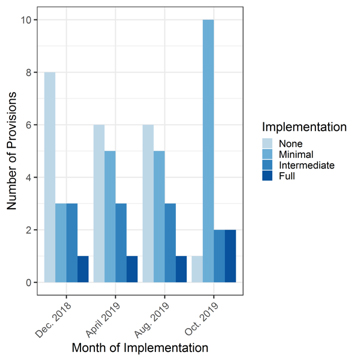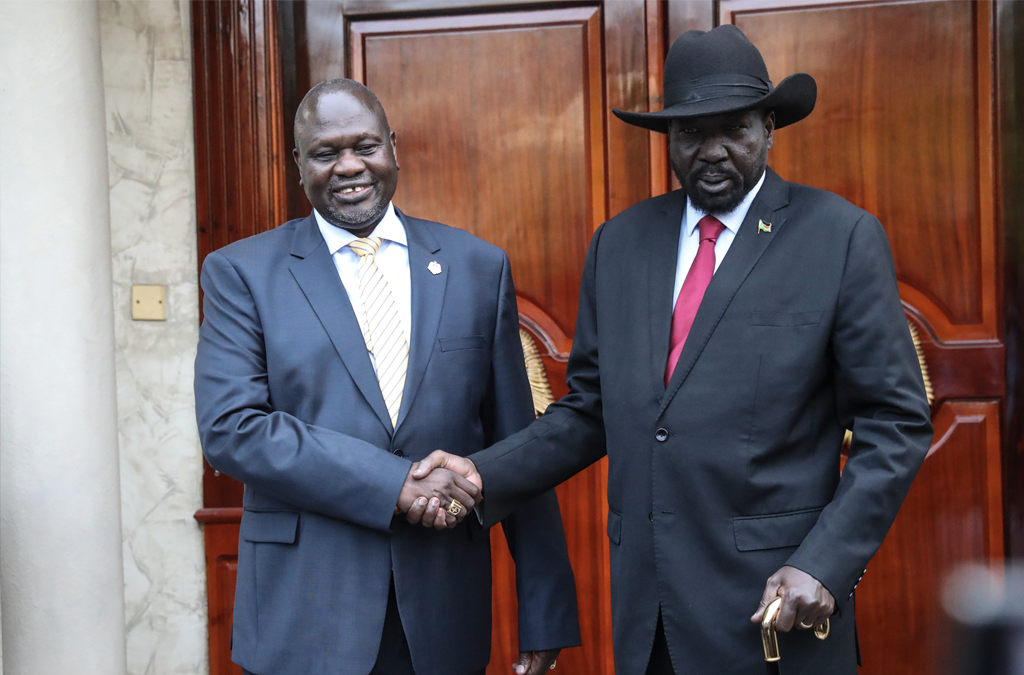Matthew Hauenstein and Madhav Joshi
On November 8, 2019, the parties to South Sudan’s 2018 peace agreement approved a second extension of its initial implementation period. This new extension is intended to conclude with the inauguration of a unity government between incumbent President Salva Kiir and opposition leader Riek Machar. This hundred-day period leaves little time to implement the agreement’s outstanding provisions before the new deadline.
In this article, we highlight some recent findings from the Peace Accords Matrix (PAM) project’s recent policy brief on the status of the implementation of the agreement, and we offer potential policy solutions based on comparative peace process research.[1] We emphasize the need for greater political space and more frequent face-to-face meetings of Kiir and Machar to resolve implementation impasses. In addition, we call on regional and international actors to re-engage with the peace process. Lastly, we emphasize the need for greater civil society involvement in the implementation process.
Status of the 2018 Agreement
In our examination of the South Sudan process, we identified twenty-seven unique provisions within the 2018 agreement based on a typology of fifty-one different provision types from thirty-four Comprehensive Peace Agreements (CPAs) signed since 1989. Fifteen of the twenty-seven provisions are intended to be implemented during the twice-extended Pre-Transitional Period. These provisions cover security-related issues, such as maintaining a ceasefire, disarming rebel forces, and creating and training the new unified forces, and also lay the groundwork for new political institutions by redrawing the boundaries of South Sudan’s states.
We tracked the implementation of these fifteen provisions monthly since the agreement was signed in September 2018, assessing each provision’s progress using the Peace Accords Matrix methodology of a four-point ordinal scale ranking the completeness of the outlined reforms. Figure 1 displays this data at four month intervals, using the status in October 2019 for the most recent interval. The majority of the provisions were behind schedule during the fourteen months of implementation, meaning that they either had not begun or had achieved only minimal progress. We found very few provisions completed or at a more advanced intermediate stage of progress.
In October 2019, nearly three-quarters of the fifteen pre-transitional reforms had achieved some progress, although mostly at a minimal level. We observed improvement over the pre-October level when the parties initiated the demobilization, disarmament, and reintegration (DDR) program to create the unified forces. Four provisions achieved a level of intermediate implementation with ratification of the agreeement by the national legislature, the ceasefire, the re-establishment of the agreement’s montoring committees, and the release of some prisoners.
Figure 1: Implementation of the Pre-Transitional Provisions

Policy Priorities for the Extension
Based on comparative peace process research, we identify three policy priorities to ensure that the peace process in South Sudan remains viable after the hundred-day extension. First, the parties need a dispute resolution mechanism. Kiir and Machar rarely meet in person, and the current extension was only secured after regional mediators negotiated an ad-hoc meeting between them. This is the second time that the agreement was at risk of collapse due to disagreements over whether to extend the initial implementation period. While this type of disagreement is common in peace processes, research shows that creating political space for the signatories to negotiate solutions mitigates the risk of disputes escalating to violence or undermining the agreement.
Second, regional mediators, the United Nations, and the United States, the United Kingdom, and Norway, who have supported the process since the war began in 2013, need to engage further with the process. In our research, we identify two causes of peace process failure: intentional shirking by the signatories, and lack of resources and capacity for implementing agreements. Both of these causes are undermining the process in South Sudan. Shirking can be mitigated through pressure from international stakeholders, who should urge the parties to meet implementation benchmarks. Lack of capacity can also be addressed through international support. In particular, the limited funding for the DDR has caused food and medicine shortfalls in several cantonment sites. The UN has significant institutional experience with DDR programming and could support the South Sudan process.
Finally, civil society needs to have a greater role in the peace process in South Sudan. There is a need to engage youth, religious actors, women’s groups, and other relevant actors to build and sustain inclusive peacebuilding momentum from the bottom up. Peace processes with significant civil society involvement, such as Northern Ireland’s Good Friday Agreement and El Salvador’s Chapultepec Agreement, achieve high implementation rates.
The South Sudan process faces many obstacles, but progress has been achieved in recent months, and more progress could result from a greater emphasis on direct dialogue, international support, and civil society participation.
Matthew Hauenstein is Postdoctoral Research Associate with the Peace Accords Matrix at the Kroc Institute for International Peace Studies.
Madhav Joshi is Research Associate Professor and Associate Director of the Peace Accords Matrix at the Kroc Institute for International Peace Studies.




